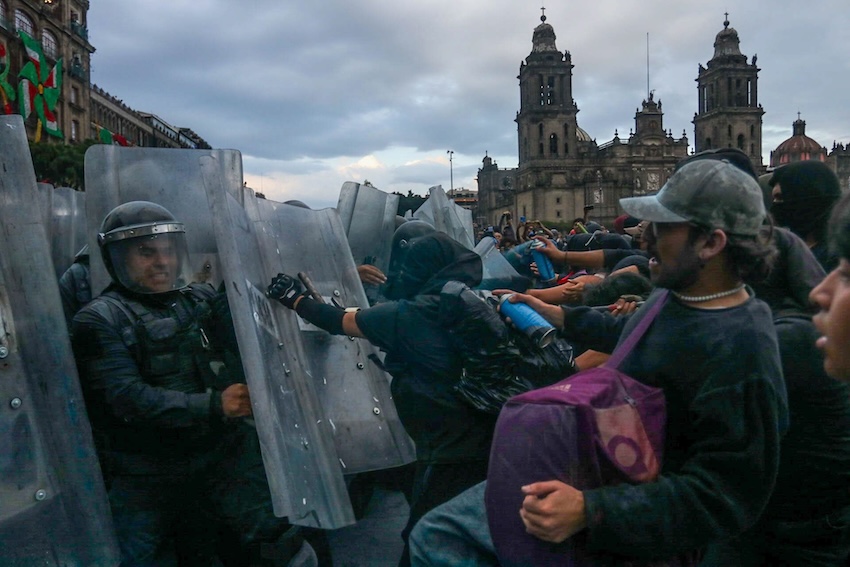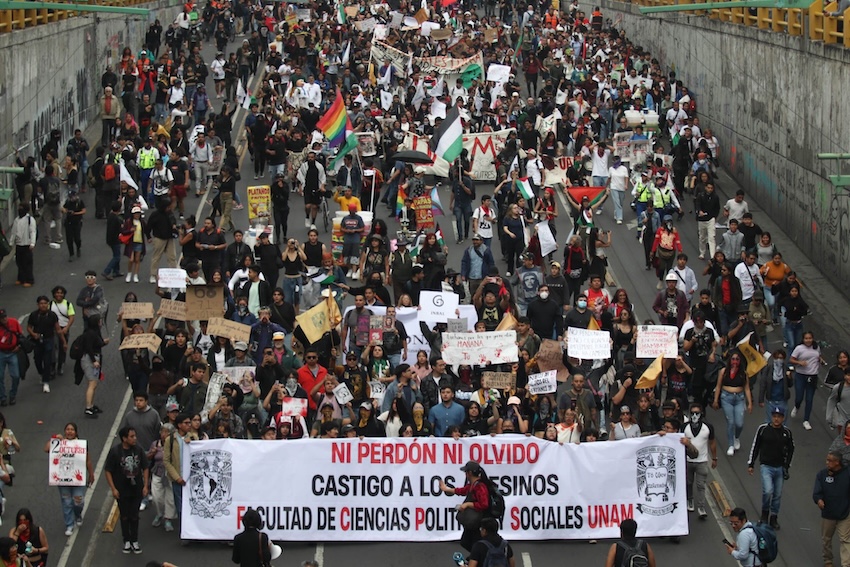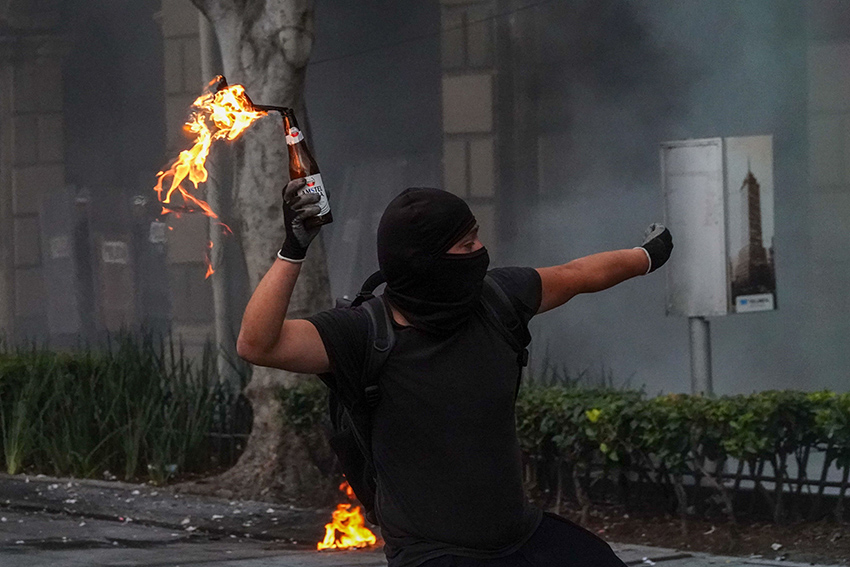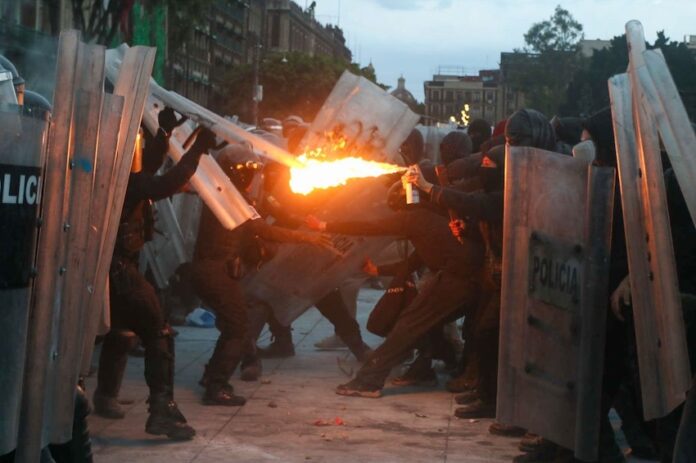Thursday’s march commemorating the 57th anniversary of the infamous Oct. 2 1968 student massacre turned violent after a minority contingent of roughly 350 demonstrators clashed with Mexico City police.
More than 120 people were injured, including 94 police officers, as a masked mob threw incendiary devices at law enforcement personnel and attacked them with hammers and stones. The so-called black bloc also smashed shop windows and looted stores.

Mexico City officials estimated 10,000 people participated in the march which did not turn violent until the throng reached the Zócalo, the capital’s main square. However, there were reports of looting and incendiary devices being hurled as the demonstration approached the Zócalo.
Mexico City Police Chief Pablo Vázquez said the approximately 350 members of a black bloc that participated in the riots were carrying clubs, Molotov cocktails, lock-picking pliers and other devices.
He said 500 police officers were initially deployed to protect the protest, but 1,000 more officers were sent to the scene once violence began.
“We condemn the violent events that occurred during the demonstration this Thursday,” Vázquez said. “There is no doubt that there are those who would like our police to act based on past models, but we will not be provoked.”
In a social media message posted on Friday morning, Mexico City Mayor Clara Brugada lauded the work of the police officers who took part in Thursday’s security operation.
“I recognize the bravery of the Mexico City police officers who resisted provocations without resorting to confrontation, she said. “Unlike in 1968, our police do not repress. Our police build peace, protect citizens and seek to ensure public safety.”
Brugada earlier said the police “acted at all times in accordance with established protocols and with the aim of safeguarding the protesters, even putting themselves at risk.” She also said the government would provide compensation to the injured officers.
While local authorities are investigating Thursday’s violence, Vázquez said they do not intend to investigate the members of the black bloc, but rather any possible crimes they may have committed.
“We don’t investigate protesters, but we do investigate crimes,” Vázquez said, “and that’s where we’re going to focus our actions.”
One person was arrested, apprehended while allegedly looting a jewelry store.

Vázquez insisted the police remain committed to guaranteeing the right to free demonstration without resorting to repressive actions.
The newspaper El Universal reported Friday that discontent among the ranks of the capital’s police is growing “because they know how to apply tactics to neutralize groups like the black bloc.”
For decades, El Universal said, law enforcement has been hamstrung by the policy that “we will not repress the people,” oft-repeated by the leftist governments that have led Mexico City since 1997.
President Claudia Sheinbaum disbanded Mexico City’s riot police in 2019 in one of her first acts as mayor of the capital, fulfilling a central demand of the 1968 student protests.
However, El Universal mused, “after [Thursday’s] looting and attacks, isn’t it time to re-evaluate that policy and admit that controlling violence at marches isn’t equivalent to repression?”
Even as the authorities and media reports indicated the police did little more than defend themselves, protect bystanders and douse flames caused by Molotov cocktails, the Mexico City Human Rights Commission (CDHCM) appeared to place some blame on the police.
CDHCM ombudsman Nashieli Ramírez told El Universal that “the presence of police in areas where groups were painting graffiti, setting fires and looting fueled the confrontation.”
Why were the protesters marching?
The violent confrontation essentially obscured the message hoped for by t the ’68 Committee for Democratic Liberties — the organizers of the march that has been a usually peaceful annual event on the Oct. 2 date of the 1968 Tlatelolco massacre.
In addition to paying tribute to the victims of the student massacre 57 years ago, protesters demanded justice in the Ayotzinapa case, an end to the genocide in Gaza and solutions to the crisis of the disappeared in Mexico.
As the violence increased, the roughly 10,000 people gathered in the Zócalo to commemorate the tragic event had difficulty hearing the speech by Félix Hernández Gamundi, a leader of the 1968 student movement.
Hernández said the violence that happened 57 years ago “was not a massacre; it was a genocide, and we must identify it accurately and call it what it was.”
“Similarly, there is no war in Gaza,” he said. “Instead, it is genocide, a practice of extermination being carried out step-by-step in the most cynical manner by a crazed ruler with fascist and repressive beliefs,” he said.
What is a black bloc?

A black bloc is a protest tactic whereby protesters wear black clothing, ski masks, scarves, sunglasses, motorcycle helmets with padding or other face-concealing and face-protecting items. It has its origins in 1980s Europe and is notable for its confrontation with authority and for the use of “justified” violence.
The clothing and face-coverings help conceal the identities of the protesters and allows the group to appear as one large unified mass.
Black bloc tactics typically feature rioting and vandalism of private property, which one black bloc collective defended as follows after the 1999 WTO protests in Seattle:
“We contend that property destruction is not a violent activity unless it destroys lives or causes pain in the process. By this definition, private property — especially corporate private property — is itself infinitely more violent than any action taken against it.”
With reports from El Universal, El Financiero, Publimetro and La Jornada
